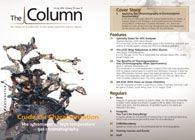Detecting Ignitable Liquids with GC–MS
Scientists from the National Institute of Standards and Technology (NIST) have demonstrated the application of PLOT-cryoadsorption (PLOT–cryo) coupled to gas chromatography–mass spectrometry (GC–MS) for the analysis of ignitable liquid (IL) residues in fire debris.
Scientists from the National Institute of Standards and Technology (NIST) have demonstrated the application of PLOT-cryoadsorption (PLOT–cryo) coupled to gas chromatography–mass spectrometry (GC–MS) for the analysis of ignitable liquid (IL) residues in fire debris. According to the study published in the Journal of Chromatography A, the method can simultaneously collect vapours from up to eight sample vials at the same time.1
When investigating the scene of a fire investigators look for evidence of ignitable liquids, such as gasoline and petrol. Debris is collected at the scene in sealed paint tins, and is then transported back to the laboratory for testing. According to the study, the most common way to sample the headspace is to use activated charcoal. The strip is held above the headspace for 2–16 h before it is extracted and analyzed using GC–MS.
Eleven different ignitable liquids were applied to Douglas fir, plywood, and nylon carpet and subsequently burnt. The charred remains were then collected into a sealed vial, before the vapours were adsorbed to short porous layer open tubular (PLOT) columns at low temperature. The capillaries were then eluted and analyzed using GC–MS.
Sampling the headspace took 3 min opposed to the 2 to 6 h typically required for the carbon strip method. The columns were then eluted and the resulting factions analyzed using GC–MS. The PLOT-cryo method was more sensitive than purge-and-trap cartridges or carbon strip sampling, and could be used with up to 7 different sorbent phases simultaneously. Furthermore, the method could be used on samples from 50 mg up to 1 kg. Thomas Bruno, corresponding author of the paper, told The Column: “Fire debris analysis can be challenging because of background interference and the low concentrations of target analytes. Since the PLOT‑cryo method of headspace collection is sensitive, selective, and fast, it offered many advantages when compared to usual methods.” - B.D.
Reference
1. J.E. Nichols, M.E. Harrie, T.M. Lovestead, and T.J. Bruno, Journal of Chromatography A1334, 126–138 (2014).

Accelerating Monoclonal Antibody Quality Control: The Role of LC–MS in Upstream Bioprocessing
This study highlights the promising potential of LC–MS as a powerful tool for mAb quality control within the context of upstream processing.
Using GC-MS to Measure Improvement Efforts to TNT-Contaminated Soil
April 29th 2025Researchers developing a plant microbial consortium that can repair in-situ high concentration TNT (1434 mg/kg) contaminated soil, as well as overcome the limitations of previous studies that only focused on simulated pollution, used untargeted metabolone gas chromatography-mass spectrometry (GC-MS) to measure their success.
Prioritizing Non-Target Screening in LC–HRMS Environmental Sample Analysis
April 28th 2025When analyzing samples using liquid chromatography–high-resolution mass spectrometry, there are various ways the processes can be improved. Researchers created new methods for prioritizing these strategies.
Potential Obstacles in Chromatographic Analyses Distinguishing Marijuana from Hemp
April 28th 2025LCGC International's April series for National Cannabis Awareness Month concludes with a discussion with Walter B. Wilson from the National Institute of Standard and Technology’s (NIST’s) Chemical Sciences Division regarding recent research his team conducted investigating chromatographic interferences that can potentially inflate the levels of Δ9-THC in Cannabis sativa plant samples, and possible solutions to avoid this problem.

.png&w=3840&q=75)

.png&w=3840&q=75)



.png&w=3840&q=75)



.png&w=3840&q=75)













